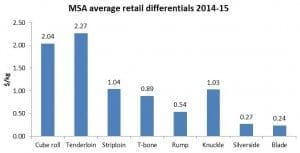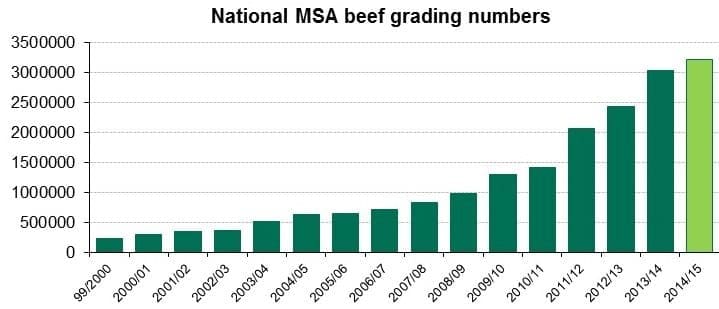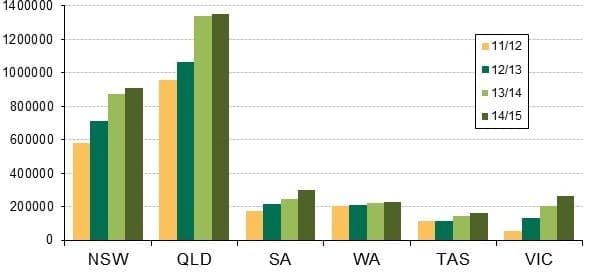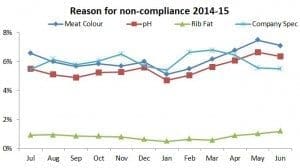THE Meat Standards Australia grading program continued to expand in 2014/15, recording a six percent increase in numbers graded to 3.22 million head.
That’s an increase of almost 200,000 head on the previous year, mostly driven through existing MSA licensed processors, now 43 in number.
All states recorded an increase in MSA beef grading activity.
Victoria, which historically been slow to adopt MSA systems, is rapidly catching up with other parts of Australia, recording a 30pc increase in numbers to 265,000 head (see graph). That came on top of a 59pc increase in volume the previous year, but both figures were coming off a relatively low base.
In other states, South Australia also showed solid growth, rising 22pc to 302,000 head; Tasmania was up 10pc to 160,000; Western Australia rose 3pc to 230,000; NSW lifted 4pc to 909,000 and Queensland was up 1pc to 1.352 million. Queensland represented 42pc of the national MSA kill.
Season has little effect on compliance
Even with the difficult seasonal conditions faced by producers in large parts of Eastern Australia this year, MSA producers have managed to maintain their compliance to MSA requirements at 93pc – exactly the same as in 2013/14.
Main reasons for non-compliance – which align closely with previous yearly performance – were high pH and/or dark meat colour. Close to 4.9pc of MSA graded cattle failed to meet the MSA pH upper limit of 5.7, while 5.6pc of cattle presented for grading had a meat colour greater than AusMeat MC 3. As is often the case, some cattle shared both high pH and high meat colour.
There was a slight improvement in the compliance to fat coverage requirements last financial year, typically around 0.5pc of cattle presented, based on rib fat.
MSA requirements do not include company specifications but relate to meeting pH, meat colour and fat coverage requirements. An additional 6pc of MSA graded cattle failed to meet company imposed processor specifications last year.
Optimisation, Index
During 2014/15, a new beef carcase sorting system, MSA optimisation was implemented. All MSA processors currently MSA grading have now implemented the optimisation model.
The MSA index for beef was also introduced during 2014/15 to provide a meaningful eating quality feedback measurement for producers. All cattle that met MSA minimum requirement and company specifications have a MSA index calculated.
The average MSA index in 2014-15 for all MSA cattle was 57.61 – an increase by 0.84 points over 12 months, a significant improvement in the eating quality of MSA cattle nationally.
MSA premiums continue
MSA producer registrations also continue to grow last financial year, with a 12pc increase in numbers, taking the total number of MSA producers across Australia to 41,973. Of the +4300 new producers, more than 3500 are eligible to supply beef and 2200 specifically for sheep. Producers are increasingly adopting online registration tools with 70pc of all registrations conducted online.
 Even with increases in cattle prices this year, the average premiums for MSA continued to grow.
Even with increases in cattle prices this year, the average premiums for MSA continued to grow.
Over-the-hooks premiums for MSA yearling cattle fluctuated throughout the year but were on average 33c/kg above non-MSA yearling cattle compared to 29c/kg in 2013/14, according to NLRS’s OTH reports.
MSA yearling cattle in Queensland received the largest average premium of 40c/kg (compared to 32c/kg in 2013-14) while average premiums of 26c/kg were reported in NSW, similar to the year before.
During 2014/15, more than 2400 producers attended 51 MSA workshops held throughout the country.
Brands and end-users
Development of MSA brands continued last financial year, with an additional 21 beef and/or lamb commercial brands becoming MSA licensed. There are now 131 MSA licensed brands in the domestic and export red meat marketplace, including 115 beef-specific, 12 lamb-specific and four multi-species.
An additional 917 retail, food-service, wholesale and supermarket end-users were licensed to carry the MSA trademark during the year, up 33pc compared to 2013/14. There are currently 346 MSA-licensed wholesalers supplying 3330 MSA-licensed food service and retail outlets across the country.
Independent butcher surveys conducted throughout the year by Millward Brown suggested 55pc of 1301 butchers surveyed sold MSA beef and provided pricing information about MSA and non-MSA beef. Ninety one percent of those butchers also rated their satisfaction with MSA beef as good to excellent, compared to 90pc in 2013/14.
The average retail price differential between MSA and non-MSA YG major primals was $1.04/kg in 2014/15 compared to $1.00/kg the previous year. Tenderloin again showed the highest price differential at $2.27/kg. The price differential on MSA knuckles increased significantly at $1.03/kg compared to $0.18/kg in 2013/14.
Audit process
AusMeat-scheduled audits of MSA-aligned businesses during the year produced zero critical Corrective Actions raised during 2014/15. The incidence of major Corrective Actions was also reduced, while 5pc of outlets audited received a major Corrective Action. MSA USDA Process Verified audit was conducted during 2014/15 with no corrective actions or observations raised.



